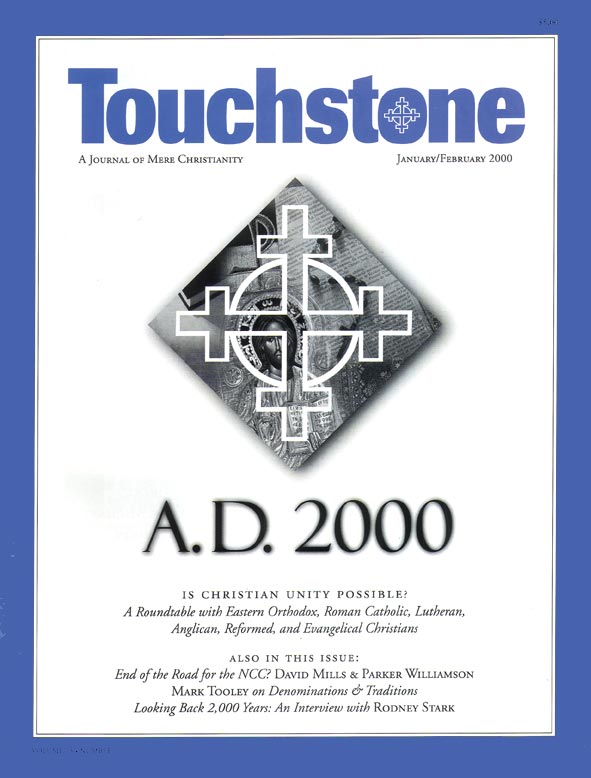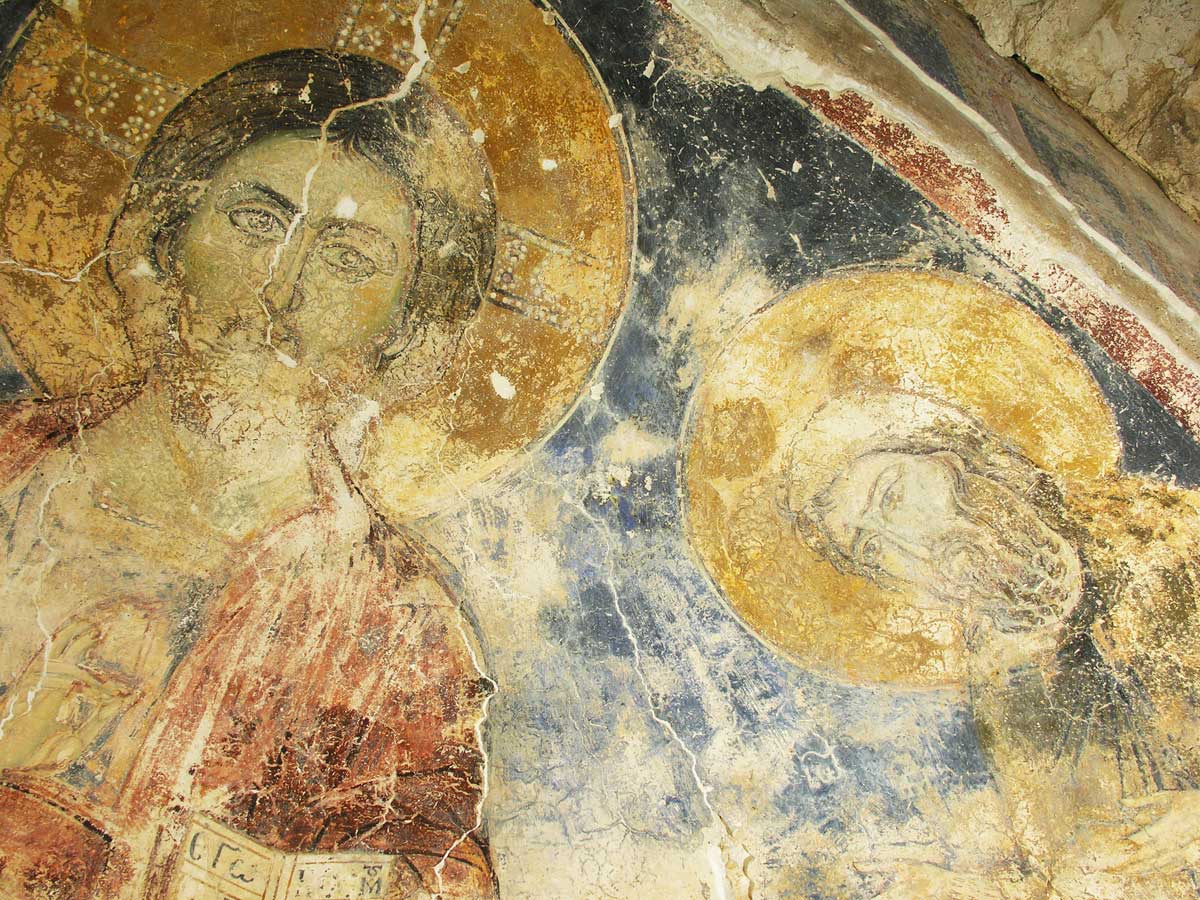The Recovering of the Altars
Beyond the Prosaic: Renewing the Liturgical Movement
edited by Stratford Caldecott
Edinburgh: T & T Clark, 1998.
(170 pages; cloth, soon to be issued in paperback)
by Richard J. Mammana, Jr.
The ease with which one can find polemical writings on modern Roman Catholic liturgy is not a cause for delight for this reviewer. Taking the liturgical movement and the reforms of the Second Vatican Council as their scapegoats for the ills of modern society, these works prophesy the demise of the Church herself with the charge that the novus ordo missae has essentially destroyed the pre-conciliar Church. So when traditional yet serious and scholarly commentary on the present and future of the Roman liturgy emerges, there is reason to take note. Beyond the Prosaic: Renewing the Liturgical Movement, the product of a Liturgy Forum in 1996 at the Oxford Centre for Faith and Culture, is just such a book. For its irenic attitude, its straightforwardly conservative stance and its candid appraisal of the state of the Roman liturgy in the wake of Vatican II, this book deserves a wide readership.
Liturgical Agendas
The book’s first essay, also its longest, surveys the various liturgical agendas that, though “not entirely separate, free of overlap or mutually exclusive,” can be discerned within the Roman Catholic Church today. In the last dozen and more years, two practices have received papal toleration: the celebration of the Mass in Latin, and the comparatively recent permission for women and girls to take part in the Mass as altar servers. That these permissions express a conciliatory attitude toward two directions in Roman Catholic practice is significant evidence for at least two agendas. But this essay also shows the reader that the fishnet categories of liberal and conservative don’t apply here. The real situation is much more complex.
The most influential and visible agenda, in fact the official agenda, according to M. Francis Mannion, is that of the International Commission on English in the Liturgy (ICEL). Mannion notes that one of “the more notable features of this agenda since the Council has been its internally evolutionary character.” Thus, though the council itself did not mandate the exclusive use of the vernacular, the Consilium responsible for reforms has allowed and directed the progressive lifting of restrictions on the vernacular, so much so that now the man in the pew will say, “Vatican II got rid of the Latin Mass.” With the Constitution on the Sacred Liturgy as its springboard, this agenda is propagated through work on the official level in liturgical revision and review today.
The second of the agendas, which has by its own high profile delineated itself the most from the others, is called “traditionalism and restoration.” Mannion places in this agenda grouping the schismatic Society of Saint Pius X (SSPX, the followers of Archbishop Marcel Lefebvre) and the numerous splinter groups deriving from it, as well as groups and orders in communion with the Holy See, such as the Priestly Fraternity of St. Peter (FSSP). “To a greater or lesser degree,” he writes, “a conviction operates among adherents of this agenda group that the authentic liturgy of Catholicism has been compromised since the Second Vatican Council and that the Mass of 1969 is fundamentally objectionable because it is neither in continuity with the pre-conciliar liturgical order nor an adequate expression of the fullness of the mystery of faith.” One wonders, however, about the placement together of such disparate groups as the SSPX and the FSSP; the former has willfully separated itself from the Church of the council while the latter adheres faithfully to the Holy See and the council while striving to preserve the Tridentine Mass under the provisions of the 1988 motu proprio Ecclesia Dei. Mannion does make it clear that the two sub-agendas are different, but their categorization together is still questionable.
(Unfortunately, Beyond the Prosaic appeared before the foundation of the Society of Saint John [SSJ], headquartered in the diocese of Scranton and dedicated to the renewal of the Church through solemn traditional liturgy. This Order, like the Priestly Fraternity of St. Peter, is growing rapidly, with young seminarians and laity offering support. The SSJ would likely have been grouped here as well, had it been active at the date of publication.)
The third agenda set forth is “the reform of the reform,” an effort at a “return to the true intentions” of the council’s liturgical changes. This movement takes its primary inspiration from Monsignor Klaus Gamber’s Reform of the Roman Liturgy (San Juan Capistrano, California: Una Voce Press, 1993), a powerful and succinct critique of the Mass versus populum and other “reforms that were actually introduced.” Cardinal Ratzinger’s introduction to the French edition of this book, and the efforts of such groups as Father Joseph Fessio’s Adoremus, indicate the level of support for this strategy of “authentic renewal” of the liturgy “in keeping with the principles of the Second Vatican Council,” though avoiding those things done after the council proper.
“Inculturating the reform” is the aim of the fourth movement that Mannion postulates. It seeks “a new pluralisation, diversification and decentralisation of Catholic liturgical life.” Overlap between this agenda and the work of ICEL and the official agenda are noted, as is the tendency for individual groups, especially in North America, to seize upon this agenda and to make it their own.
Finally, the “recatholicising of the reform” is presented as the agenda most adequate to advance ongoing liturgical reform. This agenda draws on the works of Henri de Lubac and Avery Dulles for its concept of catholicity—“not primarily . . . geographic extensiveness,” but rather the “spiritual depth, sacramental richness, religious exuberance and creativity of ecclesial institutions.” According to Mannion, this agenda incorporates the best of the other four and adds its own essential contribution: focused attention to the spiritual rather than the structural dimension of liturgical reform. Based on his experience as rector of the Cathedral of the Madeleine in Salt Lake City, even the “present liturgy is pastorally most edifying and expressive of Catholic fullness” when “celebrated with attentiveness to ritual and text, with spiritual profundity, nobility and solemnity, with well-formed ministerial leadership, and with rich musical, artistic and architectural elaboration.” That this kind of liturgical celebration is not by far the most often encountered in Roman Catholicism today is certainly indicative of the extent to which work needs to be done. It remains, then, for the revived liturgical movement to effect this transformation of a rite largely unappreciated by those who use it.
Recovery from Shock
The other essays of the volume are as thorough and insightful as the first. At least three others (of a total of seven, including Introduction and Conclusion) deserve some special notice.
Readers will recognize as unique the perspective of Archimandrite Serge Keleher, the Byzantine Catholic editor of Eastern Churches Journal, who offers his “View from the East,” asking “What Happened to the Liturgical Movement?” As a worshiper in a tradition that has experienced growth and change much less rapidly than the Latin Rite in this century, Keleher asks to where the thoroughgoing “traditionalism” of the Liturgical Movement led by Bouyer, Beauduin, Casel, Jungmann, Daniélou, and others has disappeared, despite the expressed intent of the council to promote the liturgical rejuvenation for which they labored. Instead of the fidelity to the Church and her traditions, reverence for the liturgy, dedication to patristic revival, desire for greater knowledge of the liturgy, and profound interest in the Eastern Churches that, among other elements, characterized our century’s earlier efforts at liturgical renewal and reform, something altogether different has resulted. Keleher calls it “Post-Conciliar Shock,” and he quotes the lamenting words of the 73rd Psalm to describe it in an apt reference, here abridged:
At the upper entrance they hacked the wooden trellis with axes. And then all its carved wood they broke down with hatchets and hammers. They set Thy sanctuary on fire; to the ground they desecrated the dwelling place of Thy Name. And no one knows how long this will last!
In practical terms, he refers to the “idolisation of practicality,” a development of “authoritarian clericalism” and “uneducated and unconcerned clergy” as the reasons for the decline of the movement when it seemed so sure to succeed in its aims. This, coupled with a simple lack of reverence and an overwhelming preference for the Low Mass in conjunction with a “passion for uniformity and a terror of pluralism” (author’s emphasis), has led to empty churches and a lack of transcendent liturgy in many parishes.
Keleher offers some suggestions for the advancement of the restoration of a “deeply prayerful involvement” in the liturgy: “an accurate, suitable translation” of the novus ordo missae possibly according to the hieratic English of the Book of Common Prayer is a primary need. He also calls for the gradual and patient restoration of the eastward position for celebration: “the coercive methods used to introduce the versus populum position must not be repeated.” Keleher also points to the revival of the role of Gregorian chant in the Mass as a desirable objective.
Eamon Duffy’s article on the linguistic problems of liturgical translation brings the same brilliant mind that produced The Stripping of the Altars (Yale University Press, 1993) to consider what exactly the role of those working with the texts themselves has been in the development of liturgy since the council. Duffy contends, with Jungmann, that “some sense of the classical and normative status of the ancient prayers of the Church is fundamental to Catholic Christianity” and then examines the extent to which the 1973 English translation of the Roman Missal remains faithful to the meaning and theology of the prayers in the original Latin. He finds that Cranmer in fact often renders more fully than the ICEL the “rhetorical force and theological depth of the originals.” In fact, Duffy finds more than a few places in which the translations of the Collects in the 1973 Missal give insights more into the left-leaning theological persuasions of the translators than to the real meaning at the heart of their words. While he recognizes, in a memorable phrase, that “there is more between us and these prayers than a twenty-five-year hiccup”—because for “English-speaking Catholics under the age of forty-five” these translations “[are] the Roman Liturgy”—Duffy looks forward to a new translation of the Sacramentary. Even so, he fears that we “may be witnessing the dissolution of any coherent sense of the ‘Roman Rite’” because of “shoddy workmanship” and plain ignorance of “the deep resources of our tradition.”
Singing & Texts
One more essay, on “Sung Theology: The Liturgical Chant of the Church” is remarkable for the beauty and clarity with which it explains the role of singing in the liturgy. Here, Marc-Daniel Kirby, a Cistercian, plumbs the depths of patristics and Tradition to find that Missa cantata is historically the norm rather than the exception in Christian worship, and that there are solid theological reasons for this. At the heart of the matter, “by virtue of its sacramental and liturgical functions . . . chant illustrates the great law of sacramental economy set in motion by the Incarnation.” The performance of chant finds its best expression in an “iconic transparency” in “humble service of the mysteries.”
Chant, writes Kirby, draws all members of the liturgical assembly into the actio, and through the actio into the Mystery. “As sung theology, chant is apophatic in its silences and cataphatic in its delivery of the word.” Unlike conventional hymn-singing, chant offers a spiritual dimension of expression to the human breath and voice, pointing to that “‘voice of a great multitude, like the sound of many waters’ (Revelation 19:6), the sound of the glorious and eternal leitourgia celebrated in the heavenly Jerusalem.” Read in conjunction with Thomas Day’s entertaining and insightful Why Catholics Can’t Sing, “Sung Theology” adds a theological dimension to the aesthetic and pastoral implications of singing in the parish addressed by its more popular counterpart.
Finally, there is the text of the Oxford Declaration on Liturgy, offered as the Appendix. First, the declaration notes its approval of the “positive results” of the council’s liturgical reforms; among these, it mentions “the introduction of the vernacular, the opening up of the treasury of the Sacred Scriptures, increased participation in the liturgy and the enrichment of the process of Christian initiation.” However, the declaration goes on, “bureaucratic, philistine and secularist” forces have “frustrated” the true aims of the pre-conciliar liturgical movement and the very intentions of the council itself. The end of this has been the near destruction and disappearance “without trace” of “many ancient traditions of sacred music, art and architecture.” To counter this trend, Kirby suggests that “the enrichment, correction and resacralisation of Catholic liturgical practice is necessary.” Toward that end, “a closer and deeper acquaintance with the liturgical, theological and iconographic traditions of the Christian East” will be helpful, along with increased attention to the Liturgy of the Hours and Eucharistic Adoration. He also recommends greater “pluralism” in “rites and uses” so that different elements of tradition “may flourish . . . in the period of reflection and ressourcement that lies ahead.” One also sees the hope that coercion will not be the modus operandi of church authorities: we find a call to “the utmost caution and sensitivity to the sensus fidelium, from a thorough understanding of the organic nature of the liturgical traditions of the Church.” The declaration ends with more hope, echoing Liturgical Movement pioneer Lucien Deiss’s Springtime of the Liturgy: “we await the return of spring.”
As a balanced statement of the best motivations for a revived liturgical movement, the declaration offers serious challenges to the practice of the last thirty years and more. It is to be hoped that through the efforts of conferences such as the one at Oxford that produced this volume, and through like-minded publishing concerns, winter will end with the return of spring.
Not since Gamber’s own book has a conservative critique of the abuses of the novus ordo missae held my attention so well, so completely, and so enjoyably. And, as in all good books on the liturgy, readers from backgrounds other than Roman Catholic—such as this reviewer—will have much to learn as well.
Richard J. Mammana, Jr., is a student at Columbia University, where he plans to complete undergraduate studies before entering seminary.
subscription options
Order
Print/Online Subscription

Get six issues (one year) of Touchstone PLUS full online access including pdf downloads for only $39.95. That's only $3.34 per month!
Order
Online Only
Subscription

Get a one-year full-access subscription to the Touchstone online archives for only $19.95. That's only $1.66 per month!
bulk subscriptions
Order Touchstone subscriptions in bulk and save $10 per sub! Each subscription includes 6 issues of Touchstone plus full online access to touchstonemag.com—including archives, videos, and pdf downloads of recent issues for only $29.95 each! Great for churches or study groups.
Transactions will be processed on a secure server.
more from the online archives
calling all readers
Please Donate
"There are magazines worth reading but few worth saving . . . Touchstone is just such a magazine."
—Alice von Hildebrand
"Here we do not concede one square millimeter of territory to falsehood, folly, contemporary sentimentality, or fashion. We speak the truth, and let God be our judge. . . . Touchstone is the one committedly Christian conservative journal."
—Anthony Esolen, Touchstone senior editor









